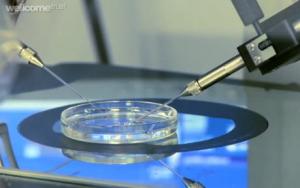Scientists at the University of Newcastle in the UK have developed a pioneering method that allows them for the first time to successfully transfer DNA between two human eggs when the baby receives the nuclear DNA from its parents and mitochondrial DNA from a mutation-free donor

The research, led by Dr. Mary Herbert and Prof. Doug Turnbull, was funded mainly by the Muscular Dystrophy Association, the Medical Research Council in Great Britain and the Wellcome Trust and was published in the journal Nature.
Every cell in our body needs energy to function. This energy is provided by the mitochondria, often referred to as the "batteries of the cell". Mitochondrial particles are found in every cell in addition to the cell nucleus while the nucleus contains the genes that determine our personality traits, the information required to create the "batteries" - the mitochondrial DNA is found in the mitochondria and passes only through the maternal line - from the mother to all her children, unlike the genes in DNA that is divided in half between the father and the mother.
An egg contains the maternal copy of the 23 DNA chromosomes as well as the DNA of its mitochondria. The amount of genetic material contained in mitochondrial DNA is very small - the 13 genes to produce proteins, compared to the approximately 23,000 genes that we inherit from our parents and which are found in DNA. The little information is used solely for the purpose of producing the energy produced by the "batteries."
Like all DNA, mitochondrial DNA can change and mothers may pass these mutations on to their children. One in 200 children born with a mutation in the mitochondrial DNA suffer in most cases from mild symptoms of the mitochondrial disease. However, 6,500 in XNUMX children develop mitochondrial diseases including muscular dystrophy, blindness, fatal heart failure, liver failure, and diabetes as well as learning disabilities. Many of these children may die in infancy. There are no treatments available to cure these diseases and mothers are often faced with an agonizing choice whether to take the risk and give birth to a child who may be affected by such a disease or not to have children at all.
Now researchers at Newcastle University have developed a technique that allows them to replace these 'batteries'. This is the first time such a technique has been used in fertilized human eggs.
The fertilized egg usually contains two pronuclei - genetic materials of the egg and the sperm as well as the mitochondria. The researchers were able to extract the pronuclei but leave behind the mitochondria. The researchers then took a fertilized egg from a donor, removed its pronuclei and replaced them with the extracted pronuclei. The newly fertilized egg contains the DNA of the father and the mother, and the mitochondria from the donor.
"What we did is like changing the battery in a laptop. "Energy delivery now works as it should, but no information on the hard drive has changed," explains Prof Turnbull. "In a child born with this method, the mitochondria function properly, but in all other respects he will receive all his genetic information from his father and mother."
Members of the Newcastle team used their technique to create eighty zygotes (fertilized eggs). These were grown for six to eight days in the laboratory with the scientists able to follow development through the blastocyst stage (the stage at which a group of around a hundred cells must be divided) under the terms of a license granted by the Human Fertility and Embryology Authority (HFEA) in 2005.
In some cases, a very small amount of the mother's mitochondrial DNA is transferred to the new egg, but since serious diseases only occur if a large number of mutations are present, this should not affect its health.
The researchers say that the study proves the principle that it is possible to prevent the transmission of mitochondrial diseases and allow the mother to give birth to a healthy child.
Unfortunately for the researchers, an amendment to the British law from 2009 prevents fertility treatments using these techniques, but they hope that in the future it will be possible to change this.

4 תגובות
R.H.:
What you say is true, but your words are not in real contradiction with my words, which in this case also seem true to me.
The degree of enthusiasm for the act is not exactly a matter worth debating.
Hey, I think you missed the point a bit. A fertilized egg contains 3 types of DNA. Genomics derived from the mother from the unfertilized egg. Another copy of the genome that originates from the father, from the sperm cell. Mitochondrial also derived from the mother from the fertilized egg. There are quite a few genetic diseases that result from a defect in mitochondrial DNA. To solve this, what the researchers did was to transfer the nucleus to another woman's enucleated egg. The technology to do this is old and is carried out in all the famous cloning attempts.
The above method opens several ethical problems such as for example the fetus will actually have 3 parents, two mothers and one father. A mother who donated half of the nuclear DNA, a father and a mother who donated the mitochondria and all of the egg's cytoplasm.
If this is really true,
This is a breakthrough whose importance is hard to overstate.
This is an opening for the genetic improvement of children who can receive hereditary loads from more than two parents.
as mentioned,
It's too good to be the simple truth...